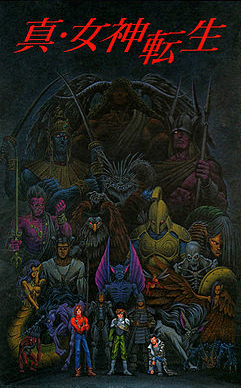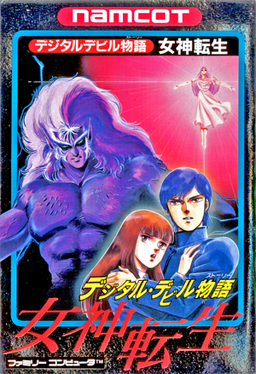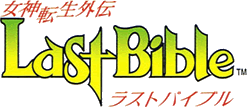This article needs additional citations for verification .(November 2008) |
The term Rakshasa, originally referring to a demon in Dharmic religions, has been used in western and Japanese literature and popular culture. The following are some examples:
This article needs additional citations for verification .(November 2008) |
The term Rakshasa, originally referring to a demon in Dharmic religions, has been used in western and Japanese literature and popular culture. The following are some examples:
The drow or dark elves are a dark-skinned and white-haired subrace of elves connected to the subterranean Underdark in the Dungeons & Dragons fantasy roleplaying game. The drow have traditionally been portrayed as generally evil and connected to the evil spider goddess Lolth. However, later editions of Dungeons & Dragons have moved away from this portrayal and preassigned alignment. More recent publications have explored drow societies unconnected to Lolth.

In the Dungeons & Dragons fantasy role-playing game, illithids are monstrous humanoid aberrations with psionic powers. In a typical Dungeons & Dragons campaign setting, they live in the moist caverns and cities of the enormous Underdark. Illithids believe themselves to be the dominant species of the multiverse and use other intelligent creatures as thralls, slaves, and chattel. Illithids are well known for making thralls out of other intelligent creatures, as well as feasting on their brains.

The manananggal is a mythical creature in the Philippines that is able to separate its upper torso from the lower part of its body. Their fangs and wings give them a vampire-like appearance.

Shin Megami Tensei is a role-playing video game developed and published by Atlus for the Super Famicom. Originally released in 1992 in Japan, it has been ported to multiple systems and eventually released in the West for iOS in 2014. It was released on the Virtual Console service in Japan on Wii in 2007 and on Wii U in 2013, as well as Nintendo Switch Online in 2020. It is the third game in the Megami Tensei series and the first in the central Shin Megami Tensei series. The gameplay uses first-person navigation of dungeons and turn-based battles against demons. The player can recruit demons as allies by talking to them rather than fighting them, and two to three demons can be fused to create new demons.

Seven Seas Entertainment is an American publishing company located in Los Angeles, California. It was originally dedicated to the publication of original English-language manga, but now publishes licensed manga and light novels from Japan, as well as select webcomics. The company is headed by Jason DeAngelis, who coined the term "world manga" with the October 2004 launch of the company's website.

Digital Devil Story: Megami Tensei refers to two distinct role-playing video games based on a trilogy of science fantasy novels by Japanese author Aya Nishitani. One version was developed by Atlus and published by Namco in 1987 for the Famicom—Atlus would go on to create further games in the Megami Tensei franchise. A separate version for personal computers was developed and published by Telenet Japan with assistance from Atlus during the same year.
Digital Devil Story: Megami Tensei II is a role-playing video game developed by Atlus and published by Namco for the Famicom. An enhanced Super Famicom port was developed by Opera House and released by Atlus in 1995. The second entry in the Megami Tensei series, the gameplay features the unnamed protagonist exploring a post-apocalyptic wasteland, battling and recruiting demons as they are pushed into taking part in a conflict between the demonic forces of Lucifer and the army of the One True God.
Tiamat is a deity in Babylonian mythology.

In the Dungeons & Dragons fantasy role-playing game, the centaur is a large monstrous humanoid. Based upon the centaurs of Greek myth, a centaur in the game resembles a human with the lower body of a horse.
In the Dungeons & Dragons fantasy role-playing game, a vampire is an undead creature. A humanoid or monstrous humanoid creature can become a vampire, and looks as it did in life, with pale skin, haunting red eyes, and a feral cast to its features. A new vampire is created when another vampire drains the life out of a living creature. Its depiction is related to those in the 1930s and 1940s Hollywood Dracula and monster movies. In writing vampires into the game, as with other creatures arising in folklore, the authors had to consider what elements arising in more recent popular culture should be incorporated into their description and characteristics.

Shin Megami Tensei: Devil Summoner is a role-playing video game developed and published by Atlus. Forming part of the Megami Tensei franchise, it is the first title in the Devil Summoner series. It was first released for the Sega Saturn in December 1995, and received a port to the PlayStation Portable in December 2005. Despite reports of it being planned for localization, neither version has been released outside Japan.

Megami Tensei Gaiden: Last Bible is a role-playing video game series developed by Multimedia Intelligence Transfer, Sega, and Menue, and published by Atlus and Sega for multiple platforms. The first game of the series, Revelations: The Demon Slayer, was released in 1992; this is the only title in the series to have been released in English. After The Demon Slayer, two sequels and five spin-off titles have been released. In the main series titles, players explore the game world and fight monsters in menu-based battles; players can also attempt to recruit monsters to their party, and can fuse two allied monsters into a single new one to try to get stronger monsters. The spin-off title Another Bible is a turn-based strategy game, while Last Bible Special is a role-playing game controlled from a first-person perspective.
Chimera, originally found in Greek mythology, is a monstrous fire-breathing creature composed of the parts of multiple animals. The term, and often the general concept, has since been adopted by various works of popular culture, and chimeras of differing description can be found in contemporary works of fantasy and science fiction.
The Goetic demon Astaroth, whose name is derived from Ashtoreth, the biblical spelling of the name of the Phoenician goddess Astarte, has appeared many times in modern popular culture.
The demon Belial, or characters named for him, have appeared in many examples of modern culture. This is distinct from medieval culture and Milton where Belial was related to the character in Jewish sources.
Abaddon, a name given to an angel, a demon or a place of destruction, has appeared many times in works of literature, films, television and popular culture.

Lilith, a biblical character suggested to be Adam's first wife and a significant female figure from Jewish mythology, has been developed over time into distinct characters in popular culture. One writer on witches, Judika Illes, wrote, "No spirit exerts more fascination over media and popular culture than Lilith. Her appearances are genuinely too numerous to count." Lilith is one of several figures with biblical or related origins integrated into popular culture who have been titled demon.
The Biblical term Moloch has traditionally been understood as a Canaanite god to whom child sacrifice was offered. In post-classical rabbinical tradition, this supposed deity was associated with Greco-Roman reports of Carthaginian child sacrifice to the god Baal Hammon. In later Christian tradition, Moloch was often described as a demon. Moloch is depicted in John Milton's epic poem Paradise Lost as one of the greatest warriors of the rebel angels, vengeful and militant.
The Canaanite god Baal in the Hebrew Bible is referenced in popular culture. Some influences in popular culture derive not from the Baal in the Hebrew Bible, but from Baal (demon) in 17th Century occult grimoires. Also Baal, through the New Testament Beelzebub, Lord of the Flies, is linked to Lucifer, or the Devil in popular culture.